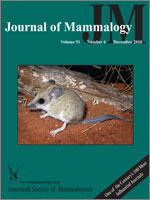Resolving phylogenetic relationships within Vespertilionidae has been difficult, with large data sets (>100 taxa, >7 kilobases) resolving portions of the phylogeny but leaving intertribal relationships within the Vespertilioninae unresolved. As a result the evolutionary history of the most speciose chiropteran family is largely unknown. The presence of short internodes followed by long terminal branches relative to other chiropteran phylogenies suggests that evolutionary rates of DNA substitution and lineage diversification could be inhibiting phylogenetic resolution. To test this hypothesis we obtained sequences of the mitochondrial DNA (mtDNA) 12s rRNA, tRNAVAL, and 16s rRNA, and the nuclear exon RAG2, resulting in more than 3 kilobases of digenomic DNA sequence data for representatives of all subfamilies and tribes within Vespertilionidae and Phyllostomidae, a family of bats that radiated at approximately the same time as Vespertilionidae. Analyses revealed that substitution rates for Vespertilionidae were significantly higher than those for Phyllostomidae, with the majority of fast-evolving lineages found within Vespertilioninae. Cladogenesis analyses characterized the vespertilionid radiation as compressed toward the root, with a rapid initial diversification, but the phyllostomid diversification was much more gradual. We suggest that ecological differences between tropical and temperate environments could have influenced diversification rates for Vespertilionidae and Phyllostomidae.
How to translate text using browser tools
16 December 2010
Identifying the confounding factors in resolving phylogenetic relationships in Vespertilionidae
Justin B. Lack,
Ronald A. Van Den Bussche
ACCESS THE FULL ARTICLE

Journal of Mammalogy
Vol. 91 • No. 6
December 2010
Vol. 91 • No. 6
December 2010
Adaptive radiation
evolutionary rates
Phyllostomidae
Vespertilionidae




